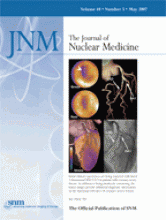Nuclear medicine is a remarkably dynamic subspecialty of medicine that requires a deep understanding of basic sciences, complex regulatory issues, and pathophysiologic processes for clinical applications. Nuclear medicine has advanced significantly during the past 10 y, with great strides in instrumentation, including that for PET/CT and SPECT/CT, which are major tools for molecular imaging. In addition, radiopharmaceutical breakthroughs in producing a highly specific agent have not been confined to a single imaging modality. However, no major, comprehensive nuclear medicine textbook has been published since the publication of the first edition of Nuclear Medicine in 1996.
In this second edition, 7 editors and 153 contributors have admirably improved on the depth and breadth of the first edition, whose objective was to provide an introductory view of nuclear medicine. They have continued to devote significant portions of the text to the basic sciences for successful practical applications. Large sections of text on techniques that are no longer commonly practiced today, such as liver or spleen imaging and radioimmunoassay, have been removed. New material such as PET/CT and SPECT/CT is covered. This beautiful, comprehensive textbook of nuclear medicine makes practical use of contemporary techniques in 1,056 illustrations, many of which are in color, forming a brilliant tapestry. Many of the renderings, along with the 190 tables and 65 boxes, are so instructive that they serve as mini tutorials on the basic and clinical sciences, protocols, and procedures. This 2-volume set is well organized, with 103 chapters divided into 9 parts (Introduction, Scientific Basis, Immunologic Aspects, Organ System Studies, Oncologic Studies, Correlative Imaging, Therapy, Inflammatory Disease, and Pediatrics). Part II, on the scientific basis, has 2 sections (Physics and Radiopharmacy), and Part IV, on organ system studies, has 7 sections (Cardiovascular, Endocrine, Gastrointestinal, Genitourinary, Musculoskeletal, Neurology, and Pulmonary). Each clinical section is preceded by a thoughtful introductory commentary.
The chapters are well-done tutorials on each application, and several chapters cover regulations and radiation safety. This book is essential for both nuclear medicine practitioners and trainees and is also useful for diagnostic radiologists, family physicians, and internists.
Footnotes
-
COPYRIGHT © 2007 by the Society of Nuclear Medicine, Inc.







